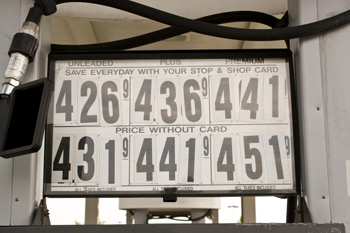 “What do you think gas prices will do over the next few months?”
“What do you think gas prices will do over the next few months?”
That may be the most popular question we hear when discussing fuels issues with reporters. It’s a surefire way to get quoted in news stories—but we never answer that question.
Why not? The biggest reason is we represent the industry that sells 80% of the fuels purchased in the U.S., so if we predict prices, that could be considered directing the market and treated as collusive behavior. Which means very very bad things for whomever at NACS is making price predictions.
This doesn’t mean we keep quiet in fueling-related conversations. Our Fuels Resource Center, for one, is full of information that explains our market and the trends. These resources are often shared with reporters so they understand your business and market conditions when they write articles.
While we cannot predict gas prices, we can share expert insights from others on where they believe the market is heading and how much consumers could be paying at the pump.
Late last year, Tom Kloza, who is the global head of energy analysis OPIS, talked with us about what the h-e-double hockey sticks was going on with gas prices in a Convenience Matters podcast. This month, Kloza penned an op-ed for CNN that suggests $4 gasoline could be a reality in the springtime, which is a little more than a few months away and roughly 60 cents more per gallon than what consumers are paying now. Remember that $4 is the national average—prices in California have already hit $4.60 a gallon there.
He said a lot of smart things that define market conditions, primarily that oil is the main contributor to gas prices. Which we also explain in “How Gas Is Priced” without stepping onto the gas-price-guessing ledge.
Kloza can—and does—dig into predictions.
“[T]he crude oil prices that provide much of the raw cost for gasoline trended higher for virtually all of 2021. In October, Brent crude, the global benchmark for oil, hit a high of $85.76 per barrel and the U.S. benchmark West Texas Intermediate reached $85.64 per barrel,” wrote Kloza, noting that the wholesale price of gasoline typically trades $10 to $20 per barrel higher than crude oil, a difference that “could soar to $40 to $50 per barrel or more this year if Omicron wanes and gasoline demand moves even higher.”
Kloza also said that President Biden is taking heat for higher energy prices for various reasons. We agree—and I think we did a good job nearly a year ago dispelling why U.S. presidents do not control gas prices.
Going back to the podcast episode, which aired the week of November 22, Kloza said that there wasn’t a person or persons to blame for higher gas prices, but we could place blame on COVID-19 recovery, “which has created a demand spurt that we’ve never seen before,” he said.
Getting to why we may see $4 gasoline this spring, Kloza alluded to the possibility during the podcast:
“I think the real problem comes in the spring. We have lost 750,000 barrels a day of U.S. refining capacity to storms and to closures just in the last five months or so and we may lose some others.”
He continues: “There’s a window I really worry about, which is spring 2022 in the second quarter where gasoline prices could go ballistic. … I think we’re going to see ‘petronoia’ this spring, and maybe this time the wolf will really be at the door. Retailers need to prepare for the volatility.”
So, there you go. Some predictions straight from an industry expert.
Wrapping up, NACS has been surveying consumers for nearly two decades to find out what they think about convenience stores and gas prices. We know from previous surveys that the price per gallon is the top reason consumers choose where to purchase gasoline. All that surveying, no matter the year, one aspect continues to ring true: Gas prices are one of the most recognizable and sensitive price points in American commerce.
In 2008, consumers told us that if the price per gallon reached $3.71, they would change their behaviors. We called this “the tipping point.” Taking that number and adjusting for inflation (2008-2021), our tipping point today would be $4.81 per gallon. Remember, we’re talking about the national average for regular gasoline—not mid-grade, premium or diesel.
Suddenly $4 gas doesn’t sound as daunting, but many factors that affect market conditions and oil prices impact the price per gallon no matter the time of year. It’s constant.
Our suggestion: Talk with your customers and explain how the market works. That’s why we created the Fuels Resource Center. Share our resources on your website and mobile app. Include links in your communications—let’s continue to tell the industry’s fuel story to consumers.
Then, when they see prices rise or fall, they’ll know why.